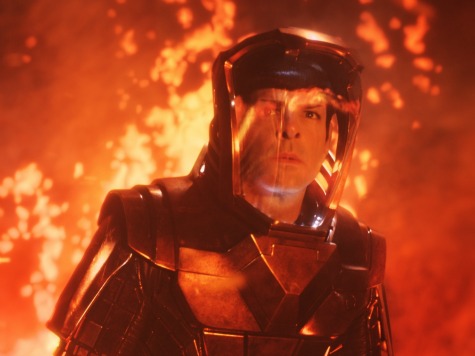
Director J.J. Abrams’ 2009 prequel to the dusty Star Trek property got the space saga out of mothballs and back on the pop culture radar.
Star Trek Into Darkness resumes the franchise’s penchant for futuristic allegories to modern times. Well, if you consider the Bush years the state of today’s foreign policy debates.
The ’60s series never bludgeoned viewers with its mission statements, and the Star Trek sequel similarly embraces razzle dazzle over speechifying. Abrams is too keenly focused on ambitious action sequences, those maddening lens flares and the bond between the ship’s crew that made those prior voyages such a pleasure.
Into Darkness opens with Mr. Spock (Zachary Quinto, an uncanny duplication of Leonard Nimoy’s iconic alien) trying to save a primitive civilization from a gurgling volcano. Captain Kirk ends up having to save Spock from a fiery finish but in doing so violates the Prime Directive (that’s Starfleet big no-no, for non-Trek fans).
Kirk is stripped of his ship as a result, but it’s handed back to him when a rogue Starfleet agent named John Harrison (Benedict Cumberbatch) flattens part of London and subsequently targets Starfleet’s high command.
Abrams and his Trek-loving collaborators pack plenty of surprises after that, some tying directly back to the original series and others referencing both prior Trek films as well as the 2009 affair. Expect a cameo or two sure to raise peals of joy in packed theaters this weekend.
The story’s underpinnings point to a clash of ideals between a hard-charging Starfleet admiral (Peter Weller) who wants to snuff out Harrison and the Enterprise crew’s more humane–read: liberal–instincts.
“This is a military operation. Is that what we are now?” wonders Scotty in a fit of progressive passion. Well, your ship is equipped with both shields and advanced weaponry.
The mission to kill Harrison creates conflict between the crew and Starfleet command. The former wants to bring the terrorist to justice through the courts, while Weller’s character wants him dead, period, even if it leads to a broader conflict with the neighboring Klingon planet.
It’s fuzzily reminiscent of the one-sided critiques conducted on screens large and small during President George W. Bush’s years in office, although one could easily connect the story to the current president’s penchant for drone strikes. Naturally, the preemptive argument for war isn’t giving much time to explain itself, nor are Harrison’s broader intentions. Cumberbatch gives the character a quiet but prickly brand of evil, but the script won’t let him become a Star Trek villain for the ages.
Star Trek Into Darkness has plenty on its mind, but it can’t be bothered with all the apolitical loose ends. Story inconsistencies start to pile up mid-film, and only Abrams’ ability to produce popcorn pleasures at whim keep us otherwise engaged.
The new crew is a sturdy lot, even when left to riff on their core personalities. Dr. McCoy (Karl Urban) is as cranky as ever, Sulu (John Cho) is stoic and calm and Scotty (Simon Pegg) handles the lion’s share of overt comic relief.
A Spock/Uhura (Zoe Saldana) romance goes nowhere beyond a few easy gags, but the bromance between Kirk and Spock remains genuine and unforced.
Star Trek Into Darkness doesn’t reach the dizzying highs of Abrams’ initial Trek adventure, and logic-loving sci-fi fans will wince at the sillier plot developments. Conservatives may bristle at the politics bubbling underneath the franchise. Abrams doesn’t lose sight of his own Prime Directive–ensure the franchise lives long and prospers beyond cheap talking points.

COMMENTS
Please let us know if you're having issues with commenting.